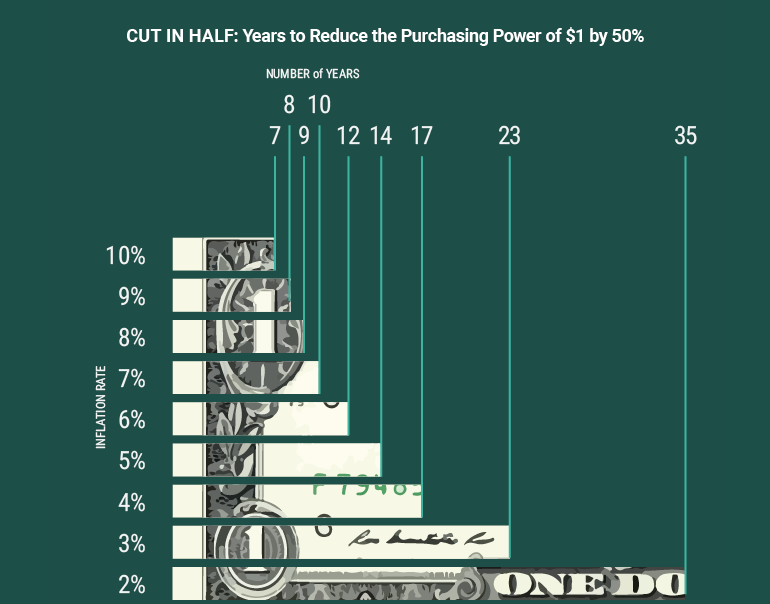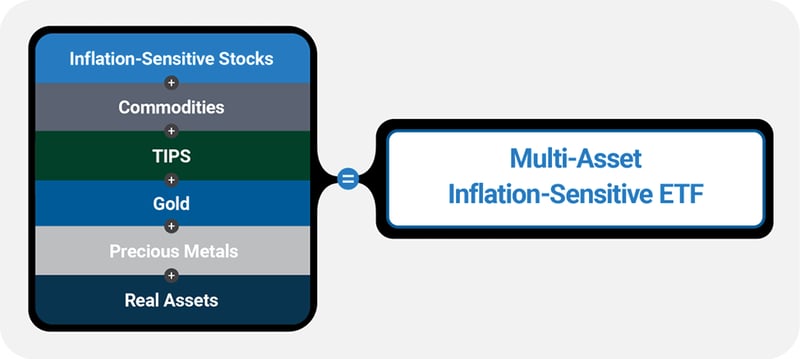Cut in Half? Why Investors Must Earn Real Returns to Overcome Persistent Inflation
Persistent, long-term inflation can cut the purchasing power of investor savings in half.
How fast?
The Problem of Stubborn Inflation
The illustration below shows how long it takes for different rates of inflation to reduce the purchasing power of your capital by half. For example, a 3% inflation rate sounds benign, but if it persists over the long haul, the impact may become significant. At 3%, it takes 23 years to cut the real value of your savings in half. For someone retiring at age 60, a dollar in your nest egg will only be worth 50¢ when you’re 83. Retirees may run out of purchasing power before they run out of cash.
The inflation challenge is real. The average inflation rate in the US over the past century (1926-2022) has been 2.9%.1 Typically, every generation of Americans has seen inflation cut their purchasing power in half. Investors must build portfolios accordingly.
Cut in Half
Years to Reduce the Purchasing Power of $1 by 50%

Source: internal calculations
Reduced to Pennies
U.S. economic history has witnessed multiple periods of double-digit inflation since World War II: 1946-1947, 1974, and 1979-1982.2 Sustained, double-digit inflation can reduce the purchasing power of $1 not just in half, but down to pennies, as illustrated below. The corrosive effect of inflation explains why central banks, policymakers and investors must remain vigilant.
What Should Investors Do?
If inflation is so corrosive to capital, what should investors do about it?
Investors must achieve real returns above inflation to meet long-term objectives, such as retirement or providing children with an education. A low risk, low return portfolio may prove to be high risk over time once inflation erodes its purchasing power. To maintain — or better yet, grow — one's purchasing power, investors must earn real returns that surpass inflation.
Inflation-sensitive investments should be a core component of a long-term approach to asset allocation. Investments that have been long-term beneficiaries of inflation include the following.
Key Inflation-Fighting Investments for Potential Real Returns
- Inflation-Sensitive Stock Market Sectors
- Commodities
- Treasury Inflation-Protected Securities (TIPS)
- Gold & Precious Metals
- Real Assets
- Multi-Asset Inflation Solutions

Diversifying among inflation-fighting assets is important, as results relative to inflation can vary widely from period to period. Each of these investments may also be subject to risk and potential losses, so risk management is key.
Learn to Maintain Your Purchasing Power
The spotlight has returned to inflation-sensitive investments. For the prudent advisor or investor, inflation should be a central consideration in the asset allocation process.
Want to learn more about preparing your portfolio to hedge against inflation?
1. Ibbotson® SBBI®, “Stocks, Bonds, Bills, and Inflation 1926–2022,” retrieved September 13, 2023.
2. US Inflation Calculator, “Historical Inflation Rates: 1914-2023,” retrieved September 13, 2023.
—
AXS Investments
AXS Investments is a leading alternative investment manager providing a diversified family of alternative investments for growth, income and diversification. The firm empowers investors to diversify their portfolios with investments previously available only to the largest institutional and high net worth investors. The investor-friendly AXS funds are time-tested, liquid, transparent and managed by high pedigreed portfolio managers with long and strong track records. For more information, visit www.axsinvestments.com.
This information is educational in nature and does not constitute investment advice. These views are subject to change at any time based on market and other conditions and no forecasts can be guaranteed. These views may not be relied upon as investment advice or as an indication of any investment or trading intent. This content should not be construed as an offer to sell, a solicitation of an offer to buy, or a recommendation for any security by AXS Investments or any third-party. All investing is subject to risk, including the possible loss of the money you invest.
ETFs involve risk including possible loss of principal. Diversification is a strategy designed to manage risk. It cannot ensure a profit or protect against loss in a declining market.
Equity Securities Risk: Equity securities may be particularly sensitive to rising interest rates, as the cost of capital rises and borrowing costs increase. Equity securities may decline significantly in price over short or extended periods of time, and such declines may occur in the equity market as a whole, or in only a particular country, company, industry or sector of the market.
Commodities Risk: Commodity prices can have significant volatility, and exposure to commodities can cause the value of an investment to decline or fluctuate in a rapid and unpredictable manner. The values of commodities may be affected by changes in overall market movements, real or perceived inflationary trends, commodity index volatility, changes in interest rates or currency exchange rates, population growth and changing demographics, international economic, political and regulatory developments, and factors affecting a particular region, industry or commodity. ETFs may utilize futures contracts for commodities investments. The risk of a position in a futures contract may be very large compared to the relatively low level of margin the underlying ETF is required to deposit. In many cases, a relatively small price movement in a futures contract may result in immediate and substantial loss or gain to the investor relative to the size of a required margin deposit. The prices of futures contracts may not correlate perfectly with movements in the securities or index underlying them.
Gold and Precious Metals Risks: Precious metal ETF shares trade like stocks, are subject to investment risk and will fluctuate in market value. The value of the shares relates directly to the value of the metals held by the ETF (less its expenses), and fluctuations in the price of the metal could materially and adversely affect an investment in the shares. The price received upon the sale of the shares, which trade at market price, may be more or less than the value of the metal represented by them.
TIPS Risk: Principal payments for Treasury Inflation-Protection Securities are adjusted according to changes in the Consumer Price Index (CPI). While this may provide a hedge against inflation, the returns may be relatively lower than those of other securities. Similar to other issuers, changes to the financial condition or credit rating of the U.S. government may cause the value of the Fund’s exposure to U.S. Treasury obligations to decline.
Distributed by ALPS Distributors, Inc, which is not affiliated with AXS Investments. AXI000342
© 2023, AXS Investments

Author: John Davi
Portfolio Manager, AXS Astoria Inflation Sensitive ETF (PPI) Mr. Davi is the CEO, CIO and Founder of Astoria Portfolio Advisors, a leading investment management firm and ETF Strategist, specializing in research driven, multi-asset ETF and thematic equity portfolio construction. He is an award-winning research strategist and has over 20 years of experience as an ETF industry leader and innovator.
Tags:
Stay Connected
Subscribe to our blog to keep up with the latest insights
Featured Posts
Related posts from blog
Check out our related posts based on your search that you may like
By the time inflation reemerged from a three-decade hibernation, Astoria Portfolio Advisors and CEO ...
Today we face a challenge that lay dormant for years. Inflation rose rapidly in 2021 driven by pande...
Inflation has been a top financial headline for a while due to its pervasive impact on consumers, bu...


